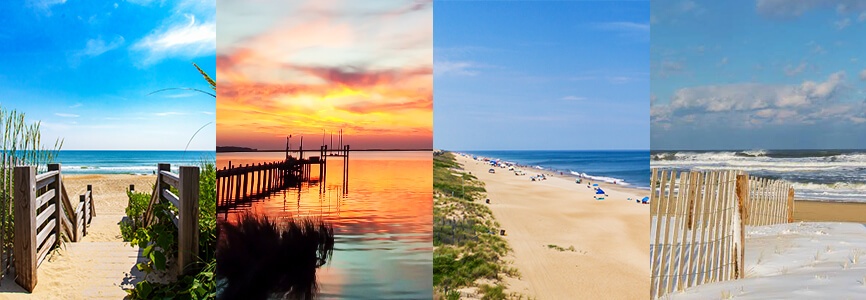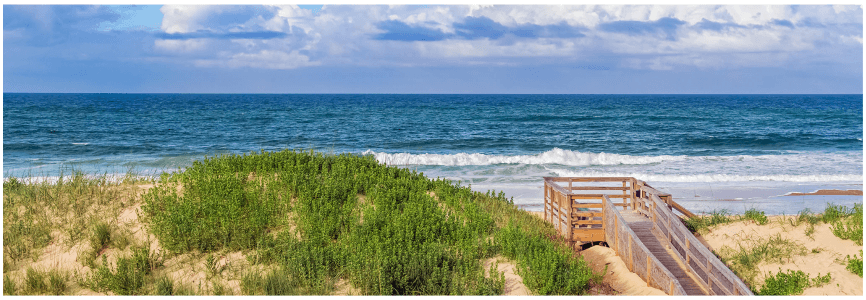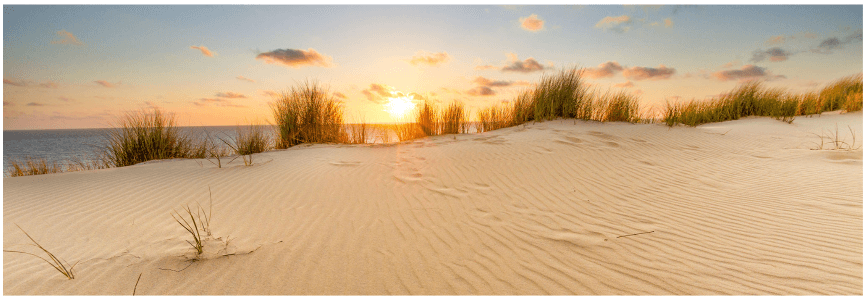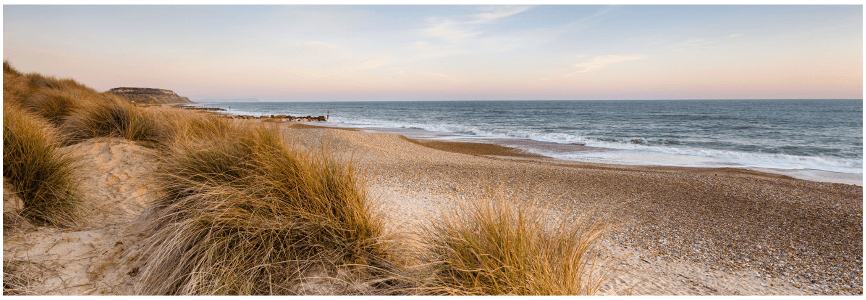When Is The Best Time Of Year To Visit The Outer Banks?
The Outer Banks is a popular coastal destination that offers unique experiences in every season. Its dynamic weather, diverse outdoor activities, and charming local events mean there’s always something special whenever you visit. To plan the perfect trip, it’s important to understand how different times of year affect the weather, crowd levels, and even the cost of vacation rentals. Choosing the best time to visit the Outer Banks based on these seasonal variations will help ensure an enjoyable and memorable getaway.
One key factor shaping the Outer Banks’ climate is the warm Gulf Stream current that flows offshore. This ocean current moderates temperatures year-round, giving the islands milder winters and temperate shoulder seasons compared to inland areas. However, each season still has distinct weather patterns and popular activities. In this guide, we break down the Outer Banks by season to help you decide when to visit for ideal weather, events, and deals on accommodations.
Outer Banks Weather Overview
Overall, the Outer Banks enjoys a temperate marine climate influenced by the Atlantic Ocean and the Gulf Stream. Summers are generally warm and humid, tempered by gentle sea breezes that provide relief on hot days. Winters are cool and can be windy, but thanks to the Gulf Stream, freezing temperatures and snow are rare on these barrier islands. On average, summer days reach the 80s °F, spring and fall hover in the 60–70 °F range, and winter highs average in the 50s °F — a much milder winter climate than many areas at the same latitude.

For mild weather and fewer crowds, many travelers find spring and fall to be the best time to visit the Outer Banks. In these shoulder seasons, the climate is pleasant and comfortable for outdoor activities without the summer heat. The beaches, parks, and attractions are also far less crowded than during peak summer months. Visitors in April, May, September, or October can enjoy uncrowded beaches and trails, shorter restaurant waits, and more accommodation choices. While summer offers prime beach weather and winter offers solitude, spring and fall strike an ideal balance between enjoyable weather and manageable crowd levels.
Spring in the Outer Banks
Spring in the Outer Banks is marked by mild temperatures, blooming landscapes, and a sense of renewal after the quiet winter. From March through May, daytime temperatures typically climb into the 60s and 70s °F, making it comfortable to explore the outdoors. You’ll see wildflowers and dune vegetation coming to life, and migratory birds returning to the area’s wildlife refuges. It’s an ideal season for hiking nature trails, biking through maritime forests, and climbing the local lighthouses under clear, crisp skies.

This season also features fun local activities and events. Spring break and Easter celebrations bring a bit of festivity to the islands without overwhelming the area. Popular events: For example, the annual Easter EGGstravaganza in Nags Head is a family-friendly festival with egg hunts and kite-flying, adding extra excitement for those visiting in early spring. With fewer tourists around, you can casually enjoy attractions like the Wright Brothers Memorial or Jockey’s Ridge State Park without crowds. Another bonus: spring visitors benefit from lower rental costs and more available options. Spring is still the off-season for Outer Banks accommodations, so vacation rental rates are more affordable and hotels often run spring specials. If you’re looking for a peaceful trip with mild weather and reasonable prices, spring is a fantastic time to visit.
Summer: Peak Season
Summer is the peak tourist season in the Outer Banks, and for good reason. From June through August, the weather is hot and beach-friendly — perfect for swimming, sunbathing, and water sports. Average highs are in the mid-80s °F (about 30 °C), and the ocean water warms up to a comfortable 70–80 °F, creating ideal conditions for surfing, paddleboarding, and snorkeling. The islands come alive with activity: all restaurants, shops, and tour operators are open for the season, and there’s a festive vacation atmosphere everywhere you go. Long, sunny days make it easy to pack in activities like morning kayak adventures on the sound, afternoon beach lounging, and evening beach bonfires or mini-golf outings with the family.
Because summer offers the best time of year to visit the Outer Banks for classic beach vacations, it also draws the largest crowds. Popular beaches can be busy, and traffic on check-in weekends (especially Saturdays) is at its heaviest. You’ll find a vibrant social scene with events like Fourth of July fireworks, outdoor concerts, and surfing competitions during these months. However, be prepared for higher costs and the need to plan ahead. Summer is when vacation rental prices reach their yearly peak, and oceanfront homes often book up many months in advance. Hotels fill quickly too, and dining out may require a wait at popular restaurants. If you plan a summer trip, secure your accommodations early (even 6–12 months ahead for prime rentals) and expect premium rates. Despite the expense and hustle, many families treasure summer in the Outer Banks for its energetic vibe, warm ocean, and full range of activities available.
Fall: A Local Favorite
Fall is often touted as the locals’ favorite time in the Outer Banks, and it’s easy to see why. From September through November, the weather gradually cools from the summer heat but generally remains pleasant. Early fall (September into early October) often still feels like summer-lite: temperatures in the 70s °F, warm ocean water lingering from August, and plenty of sunny days — but with far fewer tourists. You can still take a dip in the ocean or catch a tan on the beach in September, often without having to share the space with many others. By late October and November, temperatures dip into the 60s and upper 50s, creating crisp air that’s perfect for beach walks and lighthouse climbs. The fall light and sunsets are beautiful, and the changing colors of marsh grasses and maritime forests add to the scenery.

Autumn also brings a lineup of festivals and events that showcase the Outer Banks’ culture. Popular events: One highlight is the Outer Banks Seafood Festival in October, where visitors and residents gather in Nags Head to enjoy local seafood, live music, and crafts. There are also surfing tournaments, fishing competitions, and even the Outer Banks Marathon in November for those looking for active pursuits. With the summer rush over, restaurants and shops are more relaxed, and you’ll get more personal space at attractions. Locals love this season because they can enjoy their beaches and favorite spots with minimal crowds — often referring to early fall as “local’s summer.” Another advantage of fall is the decline in prices: vacation rental rates start dropping after Labor Day, and they continue to fall through October. This means you can often rent a spectacular beach house for a fraction of the summer cost.
It’s worth noting that fall is the peak of hurricane season (especially September). Visitors should stay aware of weather forecasts and consider travel insurance or flexible plans in case a storm approaches. Fortunately, many fall days are storm-free and absolutely gorgeous, so don’t be deterred — just stay prepared. Overall, if you’re seeking a balance of nice weather, lower crowd levels, and reduced prices, fall in the Outer Banks is an excellent choice.
Winter: A Peaceful Retreat
Winter in the Outer Banks is a quiet, peaceful retreat with its own special charm. From December through February, temperatures are cooler (often ranging from the mid-40s to 50s °F), but the climate is milder than most places at this latitude thanks to the Gulf Stream’s warming effect. Snow is uncommon, and many winter days are crisp and clear, perfect for bundling up and taking long walks on secluded beaches. The atmosphere is calm and introspective — you might have an entire stretch of shore to yourself to collect shells, watch the waves, or photograph the wild beauty of the dunes in the soft winter light.

This off-season offers a very different Outer Banks experience that appeals to those looking to escape crowds. Many of the tourist crowds are gone, so you can explore popular spots like Cape Hatteras Lighthouse or the Wright Brothers Memorial without any hustle or hurry. While some restaurants and businesses do close for the winter or reduce hours, a number of local establishments remain open year-round, often with no wait times and a friendly local vibe. Winter can be a great time for bird watching and wildlife observation – migratory birds flock to refuges like Pea Island, and you might spot Atlantic seals or whales off the coast during their migrations. Around the holidays, the community hosts events like WinterLights at the Elizabethan Gardens in Manteo, where gardens are illuminated with festive displays, adding a touch of seasonal magic to your visit.
Perhaps one of the biggest perks of a winter Outer Banks trip is the affordability. This is firmly the low season, so vacation rental rates are at their lowest and many hotels offer discounted off-season prices. You might find deals for long weekend stays or monthly winter rentals that make an extended stay very enticing. If you’re someone who values tranquility, enjoys nature, or simply wants a budget-friendly beach escape, winter in the Outer Banks provides a serene getaway with a unique coastal beauty.
Planning Your Outer Banks Vacation
Planning a trip to the Outer Banks is easier when you take seasonal differences into account. Each time of year offers something special, and a little preparation will help you enjoy it to the fullest. Here are some tips and resources to help you tailor your Outer Banks vacation to the season:
- Choose your travel season wisely: Decide which time of year aligns best with your interests and weather preferences. For instance, beach lovers might aim for the summer months for swimming and sun, while hikers or sightseers may prefer the mild temperatures of spring or fall. Anglers could target fall for excellent fishing, and those seeking solitude might opt for the quiet winter season.
- Book accommodations early: If you’re planning to visit during peak summer, reserve your vacation rental or hotel well in advance (even 6–12 months early for popular oceanfront houses). Summer availability fills up quickly. In contrast, during off-peak seasons like winter, you’ll find more flexibility and may even snag last-minute deals due to lower demand.
- Use official guides and resources: Take advantage of resources like the Outer Banks Visitors Bureau (OuterBanks.org) which offers a free travel guide, maps, and up-to-date event calendars. Local visitor centers can provide insider tips and brochures for attractions such as the wild horse tours in Corolla, the Wright Brothers National Memorial, or Cape Hatteras National Seashore. Researching these guides will help you discover local events and must-see attractions that coincide with your travel dates.
- Plan around seasonal events and hours: Look into what festivals, tours, or special activities are happening during your visit. Planning ahead for events like a seafood festival in fall or a kite festival in spring can add memorable experiences to your trip. Also, keep in mind that some attractions have seasonal hours – for example, certain historic sites or amusements may close or shorten hours in winter, whereas summer offers the most extended hours and daily activities.
- Prepare for weather changes: Always pack for the season and be ready for shifts in weather. In spring or fall, bring layers for warm days and cooler evenings. Summer travelers should pack plenty of sun protection and stay hydrated in the heat. If visiting in late summer or during hurricane season (late August through September), consider travel insurance and have a flexible itinerary in case of storms. In winter, bring a good jacket for windy beach walks. By preparing for the season’s weather, you’ll stay comfortable and safe throughout your stay.
By considering the season when planning your Outer Banks vacation, you can ensure that you have the right gear, know what to expect, and don’t miss out on any seasonal highlights. A little research and preparation go a long way toward a smooth and enjoyable trip.
Conclusion
The Outer Banks is a year-round destination, with each season offering its own unique experiences. Whether you prefer mild spring days with blooming scenery, vibrant summer beach fun, the crisp air and festivals of fall, or the serene solitude of winter, there’s an ideal time to visit for every type of traveler. Each season in the Outer Banks has something special: from tranquil nature walks and local events in the cooler months to lively ocean adventures in the summer sun.
In the end, the best time to visit the Outer Banks comes down to your personal preferences for weather, activities, and budget. If you prioritize warm ocean swimming and a bustling atmosphere, summer will suit you despite the crowds. If you value pleasant weather and fewer people, spring or fall may be your perfect window. And if you’re looking for peace, lower costs, and don’t mind cooler temperatures, winter can be wonderfully rewarding. By understanding what each season offers, you can choose the time of year that matches your vacation goals and make the most of this beautiful coastal paradise.
Frequently Asked Questions
What is the best time of year to visit the Outer Banks?
Late spring (April and May) and early fall (September and October) are often considered the best times of year to visit the Outer Banks. During these shoulder seasons, the weather is warm and pleasant, the beaches and attractions are less crowded, and rental prices are more reasonable. Summer is ideal for those seeking hot beach weather and full summertime activities, but it comes with bigger crowds and higher costs, whereas winter offers the lowest prices and tranquility but cooler temperatures.
When is the best time to book an Outer Banks vacation rental?
It’s best to book an Outer Banks vacation rental several months in advance of your trip, especially if you plan to visit during the peak summer season. Popular oceanfront homes and condos can get reserved 6–12 months early, so booking by winter or early spring for a summer stay will give you the most options. For off-season visits in spring, fall, or winter, you can often book closer to your travel dates and may find better deals or discounts due to lower demand.
When do vacation rental rates start dropping?
Vacation rental rates in the Outer Banks start dropping once the peak summer season ends, typically in late August or right after Labor Day in early September. As the busy summer crowds leave, many property owners and rental companies lower their weekly rates for the fall season. You’ll generally see significantly more affordable prices through September, October, and into the winter, making those months a budget-friendly time to plan a visit.
